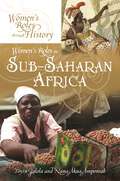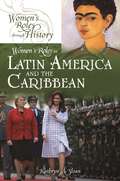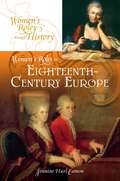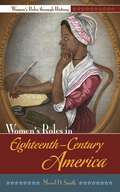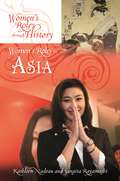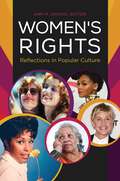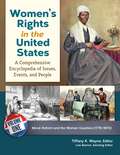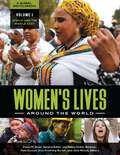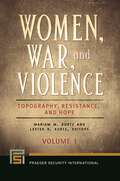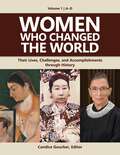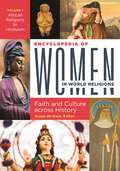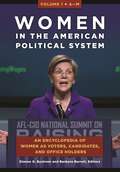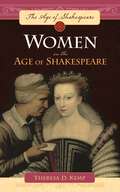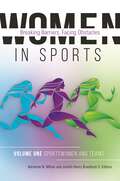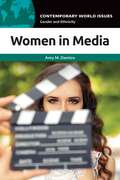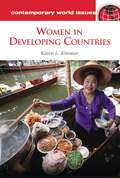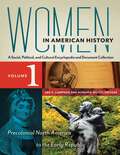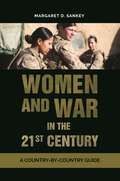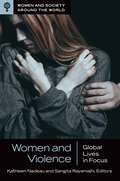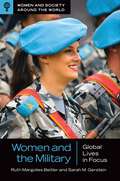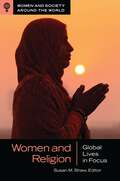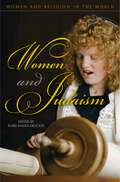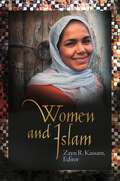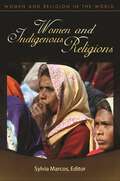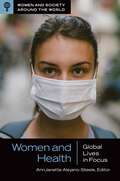- Table View
- List View
Women's Roles in Sub-Saharan Africa (Women's Roles through History)
by Dr. Toyin Falola Nana Akua AmponsahThis exhaustive exploration of the sociocultural, political, and economic roles of African women through history demonstrates how African women have shaped—and continue to shape—their societies.Women play essential, critical roles in every society; African women south of the Sahara are certainly no different. Women's Roles in Sub-Saharan Africa adds significantly to our understanding of the ways in which women contribute to the fabric of human civilization.This book provides an in-depth exploration of African women's roles in society from precolonial periods to the contemporary era. Topical sections describe the roles that women play in family, courtship and marriage, religion, work, literature and arts, and government. Each of the six chapters has been structured to elucidate women's roles and functions in society as partners, as active participants, as defenders of their status and occupations, and as agents of change. Authors Nana Akua Amponsah and Toyin Falola present a thought-provoking work that looks at the complicated victimhood/powerful-female paradigm in women and gender studies in Africa, and challenge ideological interest in African historiography that privilege male representation.
Women's Roles in Latin America and the Caribbean (Women's Roles through History)
by Kathryn A. SloanThis book surveys Latin American and Caribbean women's contributions throughout history from conquest through the 20th century.From the colonial period to the present day, women across the Caribbean and Latin America were an intrinsic part of the advancement of society and helped determine the course of history. Women's Roles in Latin America and the Caribbean highlights their varied and important roles over five centuries of time, providing geographical breadth and ethnic diversity to the Women's Roles through History series.Women's roles are the focus of all six chapters, covering themes that include religion, family, law, politics, culture, and labor. Each section provides specific examples of real-life women throughout history, providing readers with an overview of Latin American women's history that pays special attention to continuity across regions and variances over time and geography.
Women's Roles in Eighteenth-Century Europe (Women's Roles through History)
by Jennine Hurl-EamonThis concise historical overview of the existing historiography of women from across eighteenth-century Europe covers women of all ages, married and single, rich and poor.During the 18th century, the Enlightenment, the French Revolution, protoindustrialization, and colonial conquest made their marks on women's lives in a variety of ways. Women's Roles in Eighteenth-Century Europe examines women of all ages and social backgrounds as they experienced the major events of this tumultuous period of sweeping social and political change. The book offers an inclusive portrayal of women from across Europe, surveying nations from Portugal to the Russian Empire, from Finland to Italy, including the often overlooked women of Eastern Europe. It depicts queens, an empress, noblewomen, peasants, and midwives. Separate chapters on family, work, politics, law, religion, arts and sciences, and war explore the varying contexts of the feminine experience, from the most intimate aspects of daily life to broad themes and conditions.
Women's Roles in Eighteenth-Century America (Women's Roles through History)
by Merril D. SmithThis book offers a look at how the lives of women changed in the era when the United States emerged.Spanning the broad spectrum of Colonial-era life, Women's Roles in Eighteenth-Century America is a revealing exploration of how 18-century American women of various races, classes, and religions were affected by conditions of the times—war, slavery, religious awakenings, political change, perceptions about gender—as well as how they influenced the world around them. Women's Roles in Eighteenth-Century America covers the area of North America that became the United States and follows the transformation of the British colonies into a new nation. The book is organized thematically to examine marriage and the family, the law, work, travel, war, religion, and education and the arts. Each chapter combines current research and primary sources to offer authoritative portraits of real lives of the everyday women during this pivotal early era in our history.
Women's Roles in Asia (Women's Roles through History)
by Kathleen Nadeau Sangita RayamajhiThis insightful book examines women's lives across Asia, challenging typical stereotypes and providing a fresh look at the changing role of women in various regions of the vast continent.All around the world, women's important role in history has only recently been acknowledged. Asia is no exception. Despite a long record of achievements, women's experiences in South, Southeast, and East Asia go largely untold. This compelling book looks at women's lives in contemporary Asia, and reviews the cultural similarities—and differences—in the patterns and experiences of women across various regions.Women's Roles in Asia examines the full scope of women's lives throughout history, including specific topics such as education, family life, marriage and childbearing, religion, public life, economics, legal status, and literature and the arts. A timeline and introduction provide a backdrop to the events, achievements, and issues that have impacted Asian women from pre-colonial time to the present day.
Women's Rights: Reflections in Popular Culture (Issues through Pop Culture)
by Ann M. Savage, EditorCovering from 1900 to the present day, this book highlights how female artists, actors, writers, and activists were involved in the fight for women's rights, with a focus on popular culture that includes film, literature, music, television, the news, and online media.Women's Rights: Reflections in Popular Culture offers a succinct yet thorough resource for anyone interested in the relationship between feminism, women's rights, and media. It is ideally suited for students researching popular culture's role in the modern history of women's rights and representation of women, women's rights, and feminism in popular culture. This insightful book highlights of some of the most important moments of women taking a stand for women throughout popular culture history.Each section focuses on an aspect of popular culture. The television section covers important benchmarks, such as Julia, The Mary Tyler Moore Show, Roseanne, Murphy Brown, and Ellen. Coverage of films includes Christopher Strong, Foxy Brown, and Thelma & Louise; the literature section features the work of influential individuals such as Virginia Woolf, Zora Neale Hurston, and Toni Morrison. The book celebrates early musical ground-breakers like Gertrude "Ma" Rainey and Bessie Smith as well as contemporary artists Janelle Monáe and Pussy Riot. The work of key women activists—including Margaret Sanger, Angela Davis, and Winona LaDuke—is recognized, along with the unique ways women have used the power of the web in their continued effort to push for women's equality.
Women's Rights in the United States [4 volumes]: A Comprehensive Encyclopedia of Issues, Events, and People [4 volumes]
by Tiffany K. Wayne Lois BannerA comprehensive encyclopedia tracing the history of the women's rights movement in the United States from the American Revolution to the present day.Few realize that the origin of the discussion on women's rights emerged out of the anti-slavery movement of the 19th century, and that suffragists were active in the peace and labor movements long after the right to vote was granted. Thus began the confluence of activism in our country, where the rights of women both followed—and led—the social and political discourse in America. Through 4 volumes and more than 800 entries, editor Tiffany K. Wayne, with advising editor Lois Banner, examine the issues, people, and events of women's activism, from the early period of American history to the present time. This comprehensive reference not only traces the historical evolution of the movement, but also covers current issues affecting women, such as reproductive freedom, political participation, pay equity, violence against women, and gay civil rights.
Women's Lives around the World [4 volumes]: A Global Encyclopedia [4 volumes]
by Susan M. Shaw, Nancy Staton Barbour, Patti Duncan, Kryn Freehling-Burton and Jane NicholsProviding an in-depth look at the lives of women and girls in approximately 150 countries, this multivolume reference set offers readers transnational and postcolonial analysis of the many issues that are critical to the success of women and girls.For millennia, women around the world have shouldered the responsibility of caring for their families. But in recent decades, women have emerged as a major part of the global workforce, balancing careers and family life. How did this change happen? And how are societies in developing countries responding and adapting to women's newer roles in society? This four-volume encyclopedia examines the lives of women around the world, with coverage that includes the education of girls and teens; the key roles women play in their families, careers, religions, and cultures; how issues for women intersect with colonialism, transnationalism, feminism, and established norms of power and control.Organized geographically, each volume presents detailed entries about the lives of women in particular countries. Additionally, each volume offers sidebars that spotlight topics related to women and girls in specific regions or focus on individual women's lives and contributions. Primary source documents include sections of countries' constitutions that are relevant to women and girls, United Nations resolutions and national resolutions regarding women and girls, and religious statements and proclamations about women and girls. The organization of the set enables readers to take an in-depth look at individual countries as well as to make comparisons across countries.
Women, War, and Violence [2 volumes]: Topography, Resistance, and Hope [2 volumes] (Praeger Security International)
by Mariam M. Kurtz and Lester R. KurtzThis set of original articles probes the breadth of vital issues surrounding the impact of war and violence on women globally—and examines what is being done to mitigate their effects.The story of men's roles in war and violence fills headlines and history books, but the women's narrative too often goes unnoticed. This two-volume work brings women's voices to the fore, highlighting new scholarship and journalism to offer a realistic understanding of this timely topic. Including both historical context and contemporary issues, the volumes explore types of violence affecting women and girls—as victims of war and as combatants in and perpetrators of war. Equally important, it provides an in-depth look at resistance movements and peacemaking efforts, examining how these issues can—and should—be addressed.The two volumes bring together a wide range of articles by experts from various fields and backgrounds to provide the first all-inclusive overview of women, war, and violence. Other works on the subject tend to be focused on Western nations, offering a narrow view of a global issue. This compendium, in contrast, takes a truly international approach. It provides general readers, policymakers, students and scholars with a compelling collection of insights from around the world, exposing the varied experiences women have had—and continue to have—with violence and war.
Women Who Changed the World [4 volumes]: Their Lives, Challenges, and Accomplishments through History [4 volumes]
by Candice GoucherThis indispensable reference work provides readers with the tools to reimagine world history through the lens of women's lived experiences. Learning how women changed the world will change the ways the world looks at the past.Women Who Changed the World: Their Lives, Challenges, and Accomplishments through History features 200 biographies of notable women and offers readers an opportunity to explore the global past from a gendered perspective. The women featured in this four-volume set cover the full sweep of history, from our ancestral forbearer "Lucy" to today's tennis phenoms Venus and Serena Williams.Every walk of life is represented in these pages, from powerful monarchs and politicians to talented artists and writers, from inquisitive scientists to outspoken activists. Each biography follows a standardized format, recounting the woman's life and accomplishments, discussing the challenges she faced within her particular time and place in history, and exploring the lasting legacy she left. A chronological listing of biographies makes it easy for readers to zero in on particular time periods, while a further reading list at the end of each essay serves as a gateway to further exploration and study. High-interest sidebars accompany many of the biographies, offering more nuanced glimpses into the lives of these fascinating women.
Encyclopedia of Women in World Religions [2 volumes]: Faith and Culture across History [2 volumes]
by Susan De-GaiaThis reference offers reliable knowledge about women's diverse faith practices throughout history and prehistory, and across cultures.Across the span of human history, women have participated in world-building and life-sustaining cultural creativity, making enormous contributions to religion and spirituality. In the contemporary period, women have achieved greater equality, with more educational opportunities, female role models in public life, and opportunities for religious expression than ever before. Contemporaneously with this increased visibility, women are actively and energetically engaging with religion for themselves and for their communities. Drawing on the expertise of a range of scholars, this reference chronicles the religious experiences of women across time and cultures. The book includes sections on major religions as well as on spirituality, African religions, prehistoric religions, and other broad topics. Each section begins with an introduction, followed by reference entries on specialized subjects along with excerpts from primary source documents. The entries provide numerous suggestions for further reading, and the book closes with a detailed bibliography.
Women in the American Political System [2 volumes]: An Encyclopedia of Women as Voters, Candidates, and Office Holders [2 volumes]
by Dianne G. Bystrom and Barbara BurrellThis book examines how women candidates, voters, and office holders shape U.S. political processes and institutions, lending their perspectives to gradually evolve American life and values.This book provides an encyclopedic sourcebook on the evolution of women's involvement in American politics from the colonial era to the present, covering all of the individuals, organizations, cultural forces, political issues, and legal decisions that have collectively served to elevate the role of women at the ballot box, on the campaign trail, in Washington, and in state- and city-level political offices across the country. The in-depth essays document and examine the rising prominence of women as voters, candidates, public officials, and lawmakers, enabling readers to understand how U.S. political processes and institutions have been—and will continue to be—shaped by women and their perspectives on American life and values.The entries cover a range of women politicians and officials; female activists and media figures; relevant organizations and interest groups, such as Emily's List, League of Women Voters, and National Right to Life; key laws, court cases, and events, such as the Nineteenth Amendment, the Equal Rights Amendment, the Seneca Falls Convention, the passage of Title IX, and Roe v. Wade; and other topics, like media coverage of appearance, women's roles as campaign strategists/fundraisers, gender differences in policy priorities, and the gender gap in political ambitions. The text is supplemented by sidebars that highlight selected landmarks in women's political history in the United States, such as the 2012 election of Tammy Baldwin, the first openly gay U.S. senator.
Women in the Age of Shakespeare (The Age of Shakespeare)
by Theresa D. KempThis book offers a look at the lives of Elizabethan era women in the context of the great female characters in the works of William Shakespeare.Like the other entries in this fascinating series, Women in the Age of Shakespeare shows the influence of the world William Shakespeare lived in on the worlds he created for the stage, this time by focusing on women in the Elizabethan and Jacobean eras in general and in Shakespeare's works in particular.Women in the Age of Shakespeare explores the ancient and medieval ideas that Shakespeare drew upon in creating his great comedic and tragic heroines. It then looks at how these ideas intersected with the lived experiences of women of Shakespeare's time, followed by a close look at the major female characters in Shakespeare's plays and poems. Later chapters consider how these characters have been enacted on stage and in film, interpreted by critics and scholars, and re-imagined by writers in our own time.
Women in Sports [2 volumes]: Breaking Barriers, Facing Obstacles [2 volumes]
by Adrienne N. Milner And Jomills Henry Braddock IICovering a breadth of topics surrounding the current state of women in sports, this two-volume collection taps current events, sociological and feminist theory, and recent research to contextualize women's experiences in sports within a patriarchal society and highlight areas for improvement.Women are continuing to break barriers in all aspects of sports, and a growing number of people are beginning to recognize sex disparities in sports as a social problem. Additionally, women's inclusion and exclusion in sports—and their equitable and inequitable treatment on the playing field—have large-scale social, legal, health, and economic consequences. Women in Sports: Breaking Barriers, Facing Obstacles comprehensively examines the state of women in sports by considering current events, controversies, and trends as well as qualitative and quantitative research. The contributors to this volume take a sociological approach to discussing women in sports by questioning dominant assumptions surrounding notions of women's biological athletic inferiority and by examining other social constructs that affect women's experiences in sports, such as race and ethnicity, socioeconomic status, and sexual orientation. The book offers a complete and up-to-date account of women's experiences in sports through coverage of the history of women's participation in sports (with a focus on exceptional female athletes) and of the increasing number of women who are competing in traditionally male sports, such as football, baseball, and mixed martial arts. Readers will come away with a greater appreciation for the issues of equity that women face, both within the world of sports and in society in general.
Women in Media: A Reference Handbook (Contemporary World Issues)
by Amy M. DamicoThis title provides a broad overview of how women are portrayed and treated in America's news and entertainment industries, including film, television, radio, the internet, and social media.This book provides a one-stop resource for understanding the participation and representation of women in the U.S. media in such areas as narrative film, scripted television programming, advertising, video games, news, and sports. Coverage is wide-ranging and comprehensive, covering historical developments and trends as well as such relevant issues as gender disparities in pay and advancement opportunities, stereotypical gender portrayals in popular entertainment, sexual harassment in America's media and entertainment industries, and the dearth of positive media representations of women of color.Engaging with this history and reading about current issues related to this topic will be useful to those interested in understanding more about why women's engagement in media—in such roles as performer, journalist, producer, and writer—is important. It will also help readers better understand how and why problematic media representations of women hinder efforts to achieve full gender equality in American society.
Women in Developing Countries: A Reference Handbook (Contemporary World Issues)
by Karen L. KinnearThis book provides a much-needed survey of the discrimination and violence against women in developing countries, and identifies the literature and resources available about this topic.Because of improvements in communication technologies, the West has become increasingly aware of horrific examples of ongoing discrimination and violence against individual women in developing countries. As a result, more attention is being paid to the gender bias and hardship that women in developing countries face in their everyday lives, and the importance of these women in economic development and the alleviation of poverty is starting to be recognized.Women in Developing Countries: A Reference Handbook addresses topics like the status of women in developing countries; their access to education, health care, and the political process; their legal status; the extent to which they are considered property; female genital mutilation and other harmful practices; and other timely issues. This book also provides statistical information, data on selected nongovernmental organizations (NGOs) and other organizations set up to improve the lives and advance the status of women, and sources of further information in print and nonprint media.
Women in American History [4 volumes]: A Social, Political, and Cultural Encyclopedia and Document Collection [4 volumes]
by Peg A. Lamphier and Rosanne Welch, EditorsThis four-volume set documents the complexity and richness of women's contributions to American history and culture, empowering all students by demonstrating a more populist approach to the past.Based on the content of most textbooks, it would be easy to reach the erroneous conclusion that women have not contributed much to America's history and development. Nothing could be further from the truth. Offering comprehensive coverage of women of a diverse range of cultures, classes, ethnicities, religions, and sexual identifications, this four-volume set identifies the many ways in which women have helped to shape and strengthen the United States. This encyclopedia is organized into four chronological volumes, with each volume further divided into three sections. Each section features an overview essay and thematic essay as well as detailed entries on topics ranging from Lady Gaga to Ladybird Johnson, Lucy Stone, and Lucille Ball, and from the International Ladies of Rhythm to the International Ladies Garment Workers Union. The set also includes a vast variety of primary documents, such as personal letters, public papers, newspaper articles, recipes, and more. These primary documents enhance users' learning opportunities and enable readers to better connect with the subject matter.
Women and War in the 21st Century: A Country-by-Country Guide
by Margaret D. SankeyTwenty-three countries currently allow women to serve in front-line combat positions and others with a high likelihood of direct enemy contact. This book examines how these decisions did or did not evolve in 47 countries.This timely and fascinating book explores how different countries have determined to allow women in the military to take on combat roles—whether out of a need for personnel, a desire for the military to reflect the values of the society, or the opinion that women improve military effectiveness—or, in contrast, have disallowed such a move on behalf of the state. In addition, many countries have insurgent or dissident factions, in that have led armed resistance to state authority in which women have been present, requiring national militaries and peacekeepers to engage them, incorporate them, or disarm and deradicalize them.This country-by country analysis of the role of women in conflicts includes insightful essays on such countries as Afghanistan, China, Germany, Iraq, Israel, Russia, and the United States. Each essay provides important background information to help readers to understand the cultural and political contexts in which women have been integrated into their countries' militaries, have engaged in combat during the course of conflict, and have come to positions of political power that affect military decisions.
Women and Violence: Global Lives in Focus (Women and Society around the World)
by Kathleen Nadeau and Sangita RayamajhiThis important and timely reference work examines violence against women and gender-based discrimination around the world, providing a global perspective on why this kind of oppression is still occurring in the 21st century.Within the past decade, the attention that has been paid to violence against women by international government organizations such as the United Nations and World Health Organization has grown. Yet silences around the violent treatment of women remains across the world, particularly in those countries where women's rights are not protected and statistics are not available. Women and Violence encompasses a global perspective of the history, causes, and complex underpinnings of gender and violence from a multidimensional and cross-disciplinary perspective. Chapters focus on a specific world region, including North America, Latin America and the Caribbean, Europe, North Africa and the Middle East, Sub-Saharan Africa, Central and East Asia, South and Southeast Asia, and Oceania. Each chapter begins with a general discussion on its world region, then focuses on particular forms of violence against women in the more specific contexts of particular countries and in relation to the wider region. Readers will be able to make cross-cultural comparisons, learning how to view gender-based violence and women's advocacy against discrimination that is occurring around the world.
Women and the Military: Global Lives in Focus (Women and Society around the World)
by Ruth Margolies Beitler Sarah M. GersteinThis addition to the Women and Society around the World series explores the roles, challenges, and accomplishments of women in the military in countries across the globe.Around the world, millions of men serve in their countries' militaries, be it on land, on the seas, or in the air. But while many militaries have opened all positions to women, even those on the front lines, others remain closed. Countries have cited a number of reasons for their policies, including changing views of women and the military, conscription, and economic and demographic trends. Written by a professor of comparative politics at the United States Military Academy at West Point and an active duty army major, this book seeks to provide an understanding of women's roles in militaries around the world. The book is organized by region, exploring societal and cultural views of masculinity and war, as well as factors influencing changing views of women and the military, including conscription and economic and demographic trends. Topics also include sexual harassment, recruitment, and views on women's physicality and strength. High school students, undergraduates, and general readers will find this cross-cultural study a fascinating and important resource.
Women and Religion: Global Lives in Focus (Women and Society around the World)
by Susan M. ShawThis volume offers students a broad examination of the impact of religion on the lives of women around the world, focusing on differences among women, indigenous religions, the impact of religion in colonization, and resistance to religious oppression.Sexism, pervasive in religion, limits access to high leadership positions; dictates gender-related religious practices and roles; portrays women in limited ways in sacred texts; excludes or condemns them if they are lesbian, bisexual, or transgender; and makes them subject to violence by people of other faiths as well as their own.This volume is organized into eight chapters, each focusing on a different region of the world—North America, Latin America and the Caribbean, Europe, North Africa and the Middle East, Sub-Saharan Africa, Central and East Asia, South and Southeast Asia, and Oceania. Chapters cover women's status and experiences in the religions of each region, including indigenous religions and such major world religions as Christianity, Judaism, Islam, Buddhism, and Hinduism. Additionally, they cover issues of religion for women, such as women in religious leadership, women in sacred texts, LGBTQ issues in religion, the intersections of religion and politics for women, the legacy of Christian missionaries on the colonial project, religious violence against women, and women's resistance to religious oppression.
Women and Judaism (Women and Religion in the World)
by Malka DruckerContributors to Women and Judaism describe the many ways in which women are claiming a place in and changing the face of this ancient religion."Women and Judaism," the editor writes, "carries an intention to do more than bring the reader new ideas to ponder. For Jewish women, it's a charge to claim and re-claim their rightful place in their tradition … For non-Jewish sisters, we hope that it encourages you to bring change in your traditions as you learn of our effort to be counted as full members of an ancient spiritual community."In this all-encompassing exploration of Judaism for the modern woman, readers attend the first the Bat Mitzvah 70 years ago, hear an imagined response of biblical mothers asked to give up their children, and learn how each holiday contains an ecological message. Readers explore the power of women within a patriarchal tradition, including the story of the first woman rabbi. Readers see demonstrations of how women keep body, mind, and spirit alive, read a new view of biblical women as heroic role models, and enter the memory of women Holocaust survivors. Some contributors write about sexuality, power, and vulnerability, while others present the newest women's rituals, including Rosh Hodesh and mikveh.
Women and Islam (Women and Religion in the World)
by Zayn R. KassamThis balanced exploration provides the basis for an energetic engagement with what it means to be a Muslim woman in a globalized world.The expert essays in Women and Islam are designed to stimulate discussion and help readers achieve a more sober understanding of the lives of Muslim women around the world. They explore the issues Muslim women face as they fight for gender justice and meet the challenges of living in a globalized, post-9/11 world—whether in Iran or France, Ethiopia, or the United States.Each chapter examines a different part of the globe, exploring issues arising from cultural and religious codes, as well as from internal and global politics, economics, education, and the law. Readers will glimpse the many and diverse ways in which Muslim women are actively involved in addressing the conditions embedded in their discrete environments and taking up the opportunities afforded to them, adopting strategies ranging from the political to the legal, from the theatrical to the religious.
Women and Indigenous Religions (Women and Religion in the World)
by Sylvia MarcosThis book examines the critical and often undervalued contributions of women to the culture, well-being, and subsistence of their communities as active, powerful, and wise ritual specialists.From the Dalit midwives in India to the women of the Nahua region in the state of Morelos, Mexico, from the indigenous nations in Turtle Island in Canada to the shamans (male and female) of South Korea and Vietnam, there are still many vital indigenous cultures around the world in which women often hold positions of religious authority and leadership.Women and Indigenous Religions addresses specific issues in the study of religion, such as the multifaceted tensions between indigenous traditions and gender and the genealogy of positions of authority in religion or spiritual matters. A close examination reveals that native religions, with their women specialists, are still a source of inspiration for millions of men and women even in the "advanced" areas in the world. This fact challenges the opinion that indigenous cultures are becoming extinct.
Women and Health: Global Lives in Focus (Women and Society around the World)
by AnnJanette Alejano-SteeleThis volume on global women's health provides a broad overview of many conditions that impact women's health, including social and economic inequities and examples of health advocacy.The health and wellbeing of the world's population matters, but many of the female half experience unequal access to information and care that increases their health risks. This global women's health volume delves into a number of health and social factors that combine to create a lower quality of life for women. Each chapter represents a global region, featuring three to four countries, and reviews health goals and outcomes relative to the United Nations Sustainable Development Goals and World Health Organization discussions on social determinants of health. Chapters are organized to invite readers to consider environmental conditions and social determinants that create gender inequities in health around the globe. Cultural forces that impact health, including environmental risks; access to health care; reproductive health; infectious and noncommunicable diseases; behavioral/mental health; and intersectional identity considerations such as religion, ethnicity, and LGBTQ identity issues.
